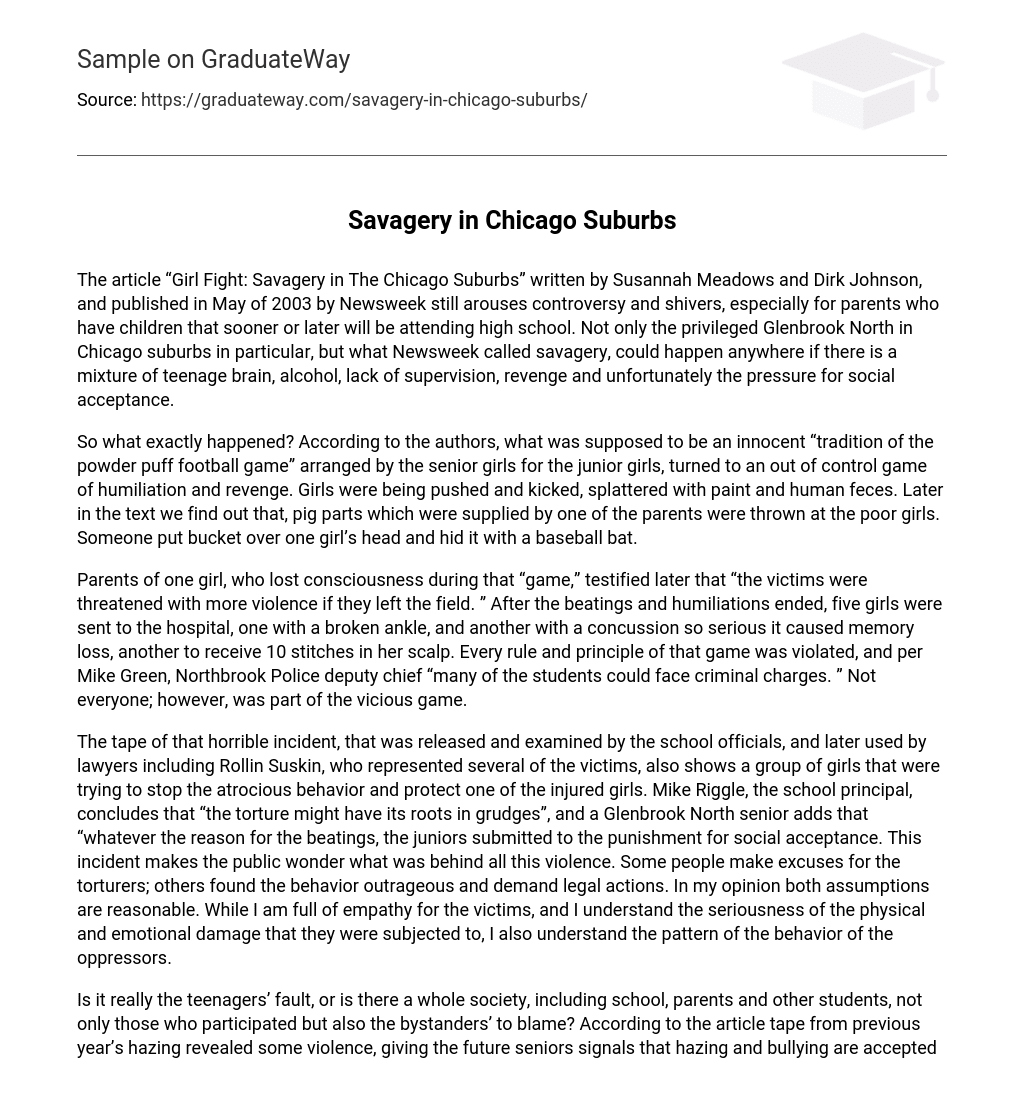The article “Girl Fight: Savagery in The Chicago Suburbs,” written by Susannah Meadows and Dirk Johnson and published by Newsweek in May 2003, continues to generate controversy and concern, particularly among parents with high school-aged children. The incident at Glenbrook North High School, which Newsweek labeled as savagery, serves as a chilling reminder that similar occurrences can happen anywhere when factors such as teenage impulsiveness, alcohol, lack of supervision, desire for vengeance, and societal pressure for acceptance come together.
According to the authors, a supposedly innocent tradition of the powder puff football game arranged by senior girls for junior girls turned into a chaotic display of humiliation and revenge. The girls suffered from pushing, kicking, and being splattered with paint and human feces. Furthermore, it was later revealed that pig parts, provided by a parent, were hurled at the unfortunate girls. In one instance, a bucket was placed over a girl’s head and concealed with a baseball bat.
During the “game,” parents of a girl who lost consciousness stated that the victims were warned of further violence if they tried to leave the field. Following the beatings and humiliations, five girls were hospitalized – one with a fractured ankle, another with a severe concussion resulting in memory loss, and another receiving 10 stitches in her scalp. The game completely disregarded every rule and principle, leading Northbrook Police deputy chief Mike Green to suggest that criminal charges may be faced by many students. However, it should be noted that not all individuals were involved in this cruel game.
The tape of the horrifying incident, examined by school officials and later used by lawyer Rollin Suskin to represent several victims, depicts a group of girls trying to halt the appalling behavior and safeguard one of the injured girls. Principal Mike Riggle speculates that grudges might be the underlying cause of this torture, while a senior from Glenbrook North suggests that the juniors subjected themselves to the punishment in order to gain social acceptance. This incident prompts questions about the motivation behind this violence. Some individuals offer justifications for the tormentors’ actions, while others find their behavior utterly outrageous and call for legal action. I believe both perspectives are valid; although I sympathize with the victims and acknowledge their significant physical and emotional suffering, I also observe a recurring pattern in how the oppressors behave.
Is the blame solely on teenagers or is there a larger responsibility within society, including the school, parents, and other students – both participants and bystanders? The article suggests that previous instances of hazing were captured on video, indicating that the school community views hazing and bullying as acceptable behaviors. Consequently, most students conform to these norms. As a result, the female seniors – who were treated as superior – escalated the game to an extreme level. However, should they be held solely accountable?
The article suggests that when parents provide alcohol and pig parts for a ritual, it sends a message to young minds that this behavior is acceptable. As a result, teenagers who were influenced by their parents’ actions had to make judgments about the situation. While feeling outraged about the victims’ experience, it is important to consider the brain development of these girls. Scientific studies show that the human brain does not fully mature until age eighteen.
Brain-imaging technology has revealed that teenagers’ brains develop at a slower pace, which helps explain their occasionally scandalous behavior. Compared to adults, adolescents often display more impulsivity, potentially offering insight into the events of that notorious Sunday in May 2003. These young individuals frequently lack full empathy and live in the present moment without considering the consequences.
Aristotle compared the passion and impulsiveness of youth to alcohol-induced intoxication. This comparison is evident when young individuals with underdeveloped brains are exposed to alcohol, lack proper supervision, and accept hazing as a societal norm. As these girls mature and become aware of their actions, the consequences they bring and the harm they cause others, they now live with haunting memories, regret, and shame. They are suffering as victims of their own mistakes. Additionally, it is crucial to acknowledge that they are not solely accountable for this situation.
Instead of providing alcohol to their children, parents should set a positive example and offer care and support. In addition, schools should actively participate in these informal events rather than claiming it is outside their jurisdiction. It is not surprising that the media stopped reporting on the incident and none of the unruly teenagers faced legal consequences, as both school officials and parents share equal or greater responsibility for the “savagery” than the girls.





